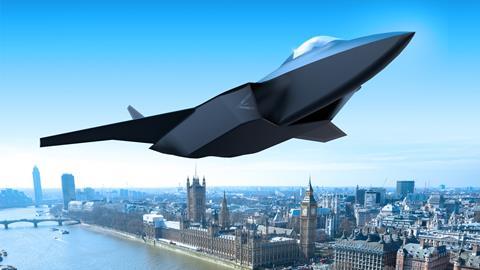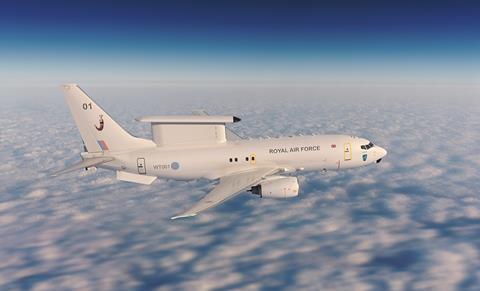RAF highlights need for strong UK defence industrial base at DSEI 2023
- Air
- News
- DSEI 2023
- Europe

Engagement with industry was among the UK Royal Air Force’s (RAF’s) main objectives as it participated at the first DSEI exhibition since Russia’s invasion of Ukraine.
“One of the biggest lessons we have taken from Ukraine: a sovereign defence industrial base has become strategic,” said Air Commodore Jim Beck, assistant chief of staff and capability strategy with the RAF. “Logistics, supply lines and an industry that can deliver in a wartime environment is something we really need to consider, and how we go from ‘just in time’ to actually on a war-footing. Our defence industrial base is as critical as our own warfighting capability, because it’s intrinsic to us being able to sustain a war-footing.”
With the US and other NATO nations having spent the last 18 months equipping Kyiv’s forces with vitally needed defensive equipment, focus has turned to equipment levels and the ability to restock supplies.
“Geographically, we are more focused on the Atlantic than we have been since the end of the Second World War, or at least the Cold War,” Beck said. “We understand that our doorstep is heating up massively.” This comes as the UK also has stepped up its planning for the potential for future conflict in the Asia-Pacific region.
“When we look at the core priorities, things have changed since IR21,” he added, referring to the UK Ministry of Defence’s (MoD’s) integrated review publication of early 2021. A refreshed document was issued in March 2023, taking note of the conflict in eastern Europe.
“It’s changing public perception, as we move out of the ‘grey zone’ into proper conflict as opposed to just competition,” Beck told FlightGlobal ahead of DSEI 2023, which took place from 12-15 September 2023. “That’s the backdrop where DSEI falls – where we are conducting the forensics of what resurgent Russia looks like."
Another point of attention for show-goers who visited London’s ExCel centre was the Global Combat Air Programme (GCAP); an initiative between Italy, Japan and the UK to jointly develop and field a new manned fighter and accompanying capabilities for use from 2035.

The UK will field a sixth-generation Tempest fighter from 2035, in partnership with Italy and Japan. Credit: BAE Systems.
Beck noted that 80% of the UK’s annual defence exports are aerospace-related, and that the MoD’s goal is to maintain this performance.
“It needs to be compelling to fit our force design, and also attractive for export,” he said, referring to a future fighter. “We need that capacitance that exports create, to grow economies of scale for our sovereign defence industrial base, and to create that mass. Unless GCAP sells lots, we won’t have a defence industrial base that is geared and mechanised to do great power wars, so we can contribute into NATO with credibility. That becomes a compelling deterrence factor.”
Beck also pointed to the importance of the ECRS Mk2 active electronically scanned array (AESA) radar upgrade for part of the RAF’s fleet of Eurofighter Typhoons as enabling future capability.
“ECRS Mk2 is as important to Typhoon as it is to GCAP,” he said about the project, under which BAE Systems lead integration of the Leonardo UK-supplied AESA array onto 40 Tranche 3 Typhoons. This will take the type to a so-called ‘Gen 4.5’ standard, and “means we are ready to deliver cutting-edge capability into GCAP”, he noted.
Although modest in size, the AESA-equipped Typhoon fleet forms part of a mix also including the UK’s Lockheed Martin F-35B Lightning IIs. “It’s more important to have a survivable platform than many [aircraft] that are less survivable,” Beck said. “Without ECRS Mk2 we are not going to have control of the air.”
With its combat air assets to work in combination with the RAF’s Boeing RC-135 Rivet Joint signals intelligence fleet and future Boeing E-7A Wedgetail airborne early warning and control and battle management platform, he said: “We are going to be able to shape the battlespace at ranges that the enemy can’t affect us.

The RAF will add Boeing’s E-7A Wedgetail to its fleet. Credit: Crown Copyright.
“From an air force perspective we have pretty much recapitalised our entire fleets,” Beck noted. "Air is in a strong position. We are a fifth-gen player, but discussing sixth-gen. We are focused on a 2035 datum: we are not focused on answering the question of 2023".
Other capabilities promoted at the show by the RAF included the service’s simulation-based training advances made via an effort named Gladiator.
“We recognise that the next war is in the synthetic environment,” Beck said. “Peacetime training has become ever more difficult because of satellite [surveillance] windows: there are techniques that we just don’t want to expose in the real environment.”
The RAF also showcased the Nexus command and control infrastructure, which Beck said was “at the centre of everything we demonstrated”.
“Nexus is an incredibly novel architecture that changes the way we send data,” he explained. “I, as a sender into the network, will fire metadata – small packets of what I have seen but that is not relevant to me – and if someone finds that of interest they can come and grab it. It also will take any product of any format and can patch them together and fuse them into a correlated track, and can even do internet scrapes to correlate those geographic positions.”
This capability protects data links and reduces bandwidth usage by only sending required information, according to Beck.
Nexus is scheduled to undergo a flight-test aboard an F-35 before the end of 2023, Beck said, which will in the future be integrated on all of the RAF’s widebody platforms. He noted that the system is the UK MoD’s intellectual property, and is also compatible with the US Air Force’s Advanced Battle Management System, US Army’s Convergence and US Navy’s Overmatch technologies.
“I took the entire capability strategy team [to the show], so all pillars of air power from now to the future: ISTAR, air mobility, control of the air and attack were there, and all the integration teams, so that they could invest into industry, so we could have a proper futures discussion,” Beck concluded.
“Our light blue [uniform] service personnel are not the be all and end all for the good ideas. We are challenging industry to come up with white papers, think pieces, or [to tell us] what do you think the future of warfare looks like? What do you think winning looks like, and what do we need to do to win? This was intended to be very much a two-way forum.”
Tags
- 2023
- 2035
- air
- base
- capability
- control
- defence
- dsei
- fleet
- forces
- future
- gcap
- industrial
- industry
- more
- need
- noted
- notes
- raf
- rafs
- show
- strong
- uk
- up
-
The move signals the company is betting on potential UK orders.
-
Applications are open for a range of emerging technology solutions which can be developed and scaled within a year.
-
The plan is heralded as the “most drastic transformation” of the country’s armed forces by the prime minister.



)
)
)